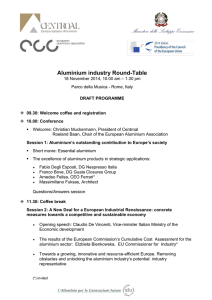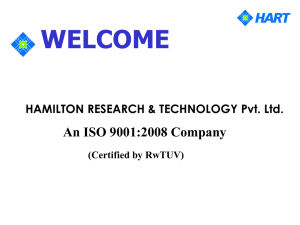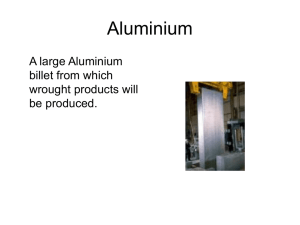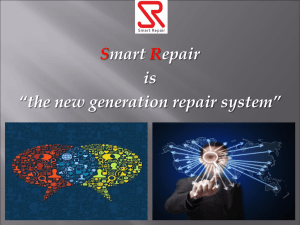Competence
advertisement
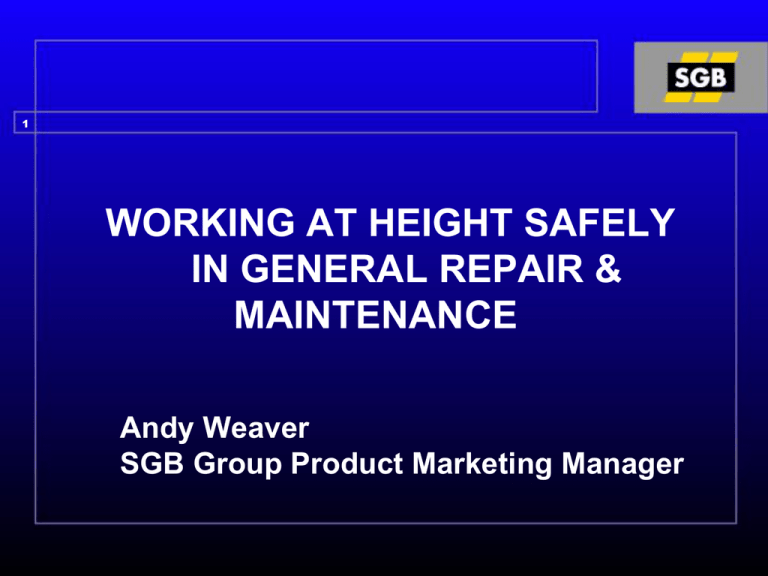
1 WORKING AT HEIGHT SAFELY IN GENERAL REPAIR & MAINTENANCE Andy Weaver SGB Group Product Marketing Manager WORK AT HEIGHT The SGB View Work at Height 3 The new Regulations : • Represent the most significant changes affecting work at height since 1966 • Are already having a radical impact on many industries Work at Height 4 Key implications for all concerned • Planning and organisational practice • Competence • Changes in attitude to access product requirements • Product selection • Product innovation Scope 5 Everyone is affected : • • • • • Main Clients Purchasing / procurement Maintenance Managers Hotel Management R & M Contractors Competence 6 “Every employer shall ensure that no person engages In any activity, including organisation, planning, and supervision, in relation to work at height or work equipment for use in such work unless he is competent to do so, or if being trained, is being supervised by a competent person.” Regulation 5 of the WAH Regulations Planning and Organisation 7 Work at Height must be : • properly planned • appropriately supervised • carried out in a manner that is safe as far as is reasonably practicable • planned including the selection of suitable work equipment in accordance with the Regulations Repair & Maintenance Access 8 The Finishing, Repair and Maintenance trades • Painting & decorating • • • • Plastering & tiling Heating & ventilating Lighting & acoustics High curtain railing – ballrooms etc • Signage • Cleaning Internal repair & maintenance 9 Common themes • • • • • Low rise applications Repetitive work Short duration applications Often low risk Is a daily requirement Selection of suitable work equipment 10 The methods we once used :• • • • • The beer or milk crate Chairs & stools Tables Steps and Ladders Anything ! Selection of suitable work equipment 11 We now need to assess every application :• the distance to be negotiated • distance & consequences of a fall • duration and frequency of use • any additional risks posed by installation and removal RISK ASSESSMENT….. Selection of Suitable Equipment Work equipment 13 According to the WAHR heirarchy we must :• Avoid working at height • Prevent falls • Mitigate the consequences of a fall Preventing Falls 14 • In much repair and maintenance activity,the work is often of short duration and of a reptetive nature • The most often used solution is the Ladder or Stepladder Ladders and Steps 15 • Risk assessment required to prove that safer equipment is not appropriate because of : • Low risk and • Short duration or site configuration Ladders & Steps : Definitions 16 Low Risk : • • • • • 3 points of contact Limited height (up to 5m for example) Can be anchored for regular work Firm, level ground Use of effective stabilising devices Short Duration : • BLMA (in consultation with HSE) suggest 30 mins NB: both above criteria must be met New product innovations 17 There is now a plethora of new low-level products available for repair and maintenance applications enabling work to be undetaken in greater comfort and with far less risk to the person carrying out the task…………. Main Product Types 18 • • • • • • • • Podium steps Room scaffolds Hop-up step platforms Height adjustable Stepladders Pop-Up work platforms Stair & spanning scaffolds Aluminium towers Plastic blocks Mobile and static Aluminium / GRP Podium Steps 19 Low- Level Internal platform to prevent falls • Compact – 1 person • Generally 150kg safe working load • Up to 1.5m platform height (2.5m working) • Meet legal guardrail requirements • Mobile • Fixed and adjustable options Podium Steps 20 • Fit through standard doorways • Easy access & egress Room Scaffolds 21 • • • • • • Prevent falls Light duty For more than 1 person Platform heights up to 6.0m Narrow width Mobile Hop-Up Step Platforms 22 • For the lowest of levels • 500mm platform height • Guardrailed / unguardrailed • 110kg – 150kg SWL • Aluminium & alu/GRP • Non-slip decks • Replaces the beer crate Height Adjustable Stepladders 23 • • • • • Platform heights up to 3.0m Handrails Platform guardrails Toeboarded Stabilised Pop-Up Work Platforms 24 • • • • • • • • Stable work platform Variable height options One-piece units Failsafe Simple operation Adjustable outriggers Lightweight & compact Easily stored Stair scaffolds 25 • For stairways & stairwells • Static unit • Through access • Narrow – less than 700mm wide • Stable • Safer than a ladder Spanning scaffolds 26 • Aluminium bridging platforms • Up and over access • Ideal for Offices & reception areas • Platform heights up to 2m • 2 persons + tools Aluminium Towers 27 • • • • • • • Prevent falls For higher applications More than one platform Built-in ladder access Stabilisers / outriggers For all trades PASMA Trained personnel Plastic blocks 28 • • • • • • • High density polyethylene 150kg SWL Block,bridge & step Totally captive unit Easy to move Simply slots together Handrail available Powered Access 29 For larger external areas • For heavier duty applications • May reduce the risks of installation • Need level ground and operator skills Conclusions 30 • Significant changes have already taken place since advent of WAHR in 2005 • Changes in culture for many trades. • The lead is coming from the major contractors. • New equipment is being developed to meet the new requirements • Further major changes will continue for some time • We will not continue with the old ways! The Role of SGB 31 • Advice • Interpreting customer needs • Staff competence • Set example • Product Innovation • Professional Services Work at Height in General Repair & Maintenance
